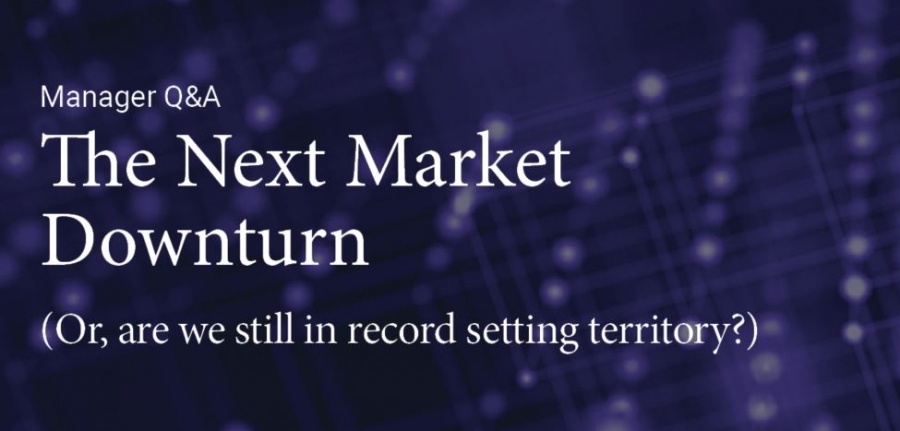
DOWNLOAD A PDF PRINTABLE VERSION
What are you anticipating over the next 12 months? Should investors be preparing for a downturn?
Historically, the market returns for a year following one that delivered attractive returns like 2019’s 31.49 percent result in another double-digit advance. In fact, in the modern era (post-1950), the average return for the S&P 500 Index has been greater than 11 percent following years where the market returned 25 + percent.
If you think about the factors that most likely led to a 25 percent plus increase, most will not revert abruptly. I believe we will continue to avoid a recession in the next 12 months, making it the longest time on record.
In addition, we are not seeing any signs of inflation. The Fed has committed to maintaining an accommodative low-interest rate environment and probably even more importantly, returning to expanding their balance sheet. We are also facing the possibility of less restraint on world trade and less disruption to world supply chains. All in all, it appears there are many signs pointing to the potential for a great environment in 2020.
What factors precipitated the last four market downturns?
Market strategists typically talk about valuation, economic factors, politics, and the like. Significant downturns have historically come when liquidity disappeared. Stocks, bonds, commodities, and currencies are priced at the margin. When investors in aggregate want to buy, that applies upward pressure. When investors are ready to sell, market liquidity is a huge factor so that sales can occur without causing disruption.
In most circumstances, the Fed establishes short-term liquidity. Historically, when they’re accommodative, as they are now having returned with their three-time Fed funds interest rate reduction this summer, and more recently by adding liquidity in response to the overnight repurchase (repo) agreement rate issue, the markets tend to be biased upward. The market went up when the Fed expanded their balance sheet and started to stumble when they contracted their balance sheet.
So, that’s why we don’t think we are looking at a downturn in the foreseeable future. When you look at other times that the market has had significant downturns, it’s often been when the Fed decides to reduce liquidity in the market.
What we are seeing is a number of positives: the economy seems to be starting to come back as evidenced by the purchasing manager’s index (PMI), interest rates are coming down, the Fed has added liquidity to the repos, and there are good signs in the supply chain and trade disruption. It’s going to be a few months before anybody sees any sign that they reversed; in similar situations in the past, markets have tended to be biased upwards.
Would it be appropriate to say that it’s business as usual, it’s a natural evolution? How then do you explain events like the big drop in 1987 and with the bursting of the tech bubble?
Those events happened primarily because the Fed started to raise interest rates as they became concerned about these bubbles. In 1987, the Fed raised rates quite a bit, and then the market corrected. They used to take a more Draconian or severe approach; when they changed so abruptly, the markets tended to react abruptly.
What’s your overall outlook for 2020?
This summer, we saw an inverted yield curve, which was accompanied by declining purchasing managers’ activity, and the political uncertainty in the recovery of a great deal of risk-off investments. Value started to beat growth, for example. The Fed’s reaction was decisive. They wanted to reduce the possibility of a slow-down, so they pushed interest rates down in three consecutive meetings and the PMI started to recover.
We’ve now seen reduction in some trade tensions, so the outlook appears pretty good for the general environment. At Plumb Funds, we are always positive about the long-term possibilities in the United States, our economy and our markets. But, more importantly, we are excited about the rise of innovation driven by many of the stocks that we own in the Funds. We think that the environment still looks very good over the next 12 to 24 months.
How can investors prepare for the year ahead? Is there anything investors should be doing in the short term?
We established the Plumb Balanced Fund because we believe investors should strive to maintain a reasonable balance in all market conditions and look at the big picture – not get caught up in the short-term pluses or minuses they may see in the stock market.
Research shows that the average investor’s returns lag the markets they invest in because they don’t maintain the balance in their investments that may allow them to benefit from the volatile, but long-term historical positive slope of the market’s returns. A balanced fund could potentially maintain that balance for investors because it stays within set parameters designed to modify risk but participate in growth potential.
In addition, investors need to maintain enough liquidity to manage their financial needs, because the markets don’t always go up. We believe it’s important to have a balanced portfolio just like you need balance in your life.
In investment markets, to us, that means investing in a type of portfolio that offers the potential to weather some economic uncertainty and challenges but still participate in long-term secular trends and companies with good business models. We believe companies that are successful in providing everyday goods and services people need or want to use regularly are good investments. Investors should be wary of daily headlines and cautious of taking on too much risk at any one time. That’s why a balanced portfolio may make sense for most people.
There’s so much going on politically. Do you think investors need to proceed with caution?
There have been significant changes in the political landscape with Brexit and the U.S. presidential impeachment process. If you would’ve asked anyone six or twelve months ago what the stock market environment would be like with that in the background, everyone would’ve been very concerned.
What we see is that the market typically reacts positively once there’s more certainty to something, and apprehensively when there is uncertainty.
Right now, it looks like the impeachment process is going to continue and be one where the Senate will probably not remove our president from office. I think the market is taking all this as a non-event. Similarly, Brexit is now set for January, and with that uncertainty is removed, people are starting to move ahead and ask the questions: “What really happened? How did it affect my daily life?” They’re seeing it’s just not as important as the press would make it out to be.
Are you making any significant changes in the Plumb Funds to take advantage of your positive outlook?
The Plumb Balanced fund is positioned with about two-thirds invested in stocks. We choose primarily domestic stocks because we believe people want to spend their money in the United States. In our view, the U.S. still offers the largest most diverse economy in the world, and companies have incredible incentives to be the most innovative; we’re seeing some real progress there.
Within the Plumb Funds, we seek to invest in companies that typically don’t need to borrow a lot of money and are not likely to be exposed to credit cycles. We prefer to invest in the types of businesses with products and services that are set up to develop recurring revenue streams, are growing, and are adding to overall economic growth. These are the kinds of companies we spend our research energies on, invest in and hold.
We do believe that the fundamentals for growth in the economy and specifically growth in the sectors of the economy that we are focused on is still going to be very strong for this year.
Thomas G. Plumb is the founding principal of Wisconsin Capital Management, LLC (formerly Thompson Plumb & Associates), which began in 1984.
Tom formerly was the lead portfolio manager of Dreyfus Premier Balanced Opportunity Fund. He earned a bachelor of business administration from the University of Wisconsin-Madison in 1975, is a member of the Madison Investment Management Society and holds the Chartered Financial Analyst designation.
IMPORTANT INFORMATION
The Fund’s investment objectives, risks, charges, and expenses must be considered carefully before investing. The prospectus contains this and other important information about the investment company, and it may be obtained on www.plumbfunds.com or by calling 866-987-7888. Read it carefully before investing.
Opinions expressed are those of the speaker as of January 7, 2020, and are subject to change, are not intended to be a forecast of future events, a guarantee of future results, nor investment advice.
Past performance does not guarantee future results.
Margin refers to money borrowed from a brokerage to trade securities.
The Purchasing Managers’ Index (PMI) is an index of the prevailing direction of economic trends in the manufacturing and service sectors. It consists of a diffusion index that summarizes whether market conditions, as viewed by purchasing managers, are expanding, staying the same, or contracting.
Risk-Off: Risk-on risk-off is an investment setting in which price behavior responds to and is driven by changes in investor risk tolerance. Risk-on risk-off refers to changes in investment activity in response to global economic patterns. During periods when risk is perceived as low, the risk-on risk-off theory states that investors tend to engage in higher-risk investments. When risk is perceived to be high, investors have the tendency to gravitate toward lower-risk investments.
S&P 500 Index is an unmanaged index which is widely regarded as the standard for measuring large-cap U.S. stock market performance.
Fund holdings are subject to change at any time and should not be considered a recommendation to buy or sell any security. References to other mutual fund products should not be interpreted as offers of those securities.
Mutual fund investing involves risk. Principal loss is possible. The fund may invest in small and mid-sized companies which involve additional risks such as limited liquidity and greater volatility. The funds invest in foreign securities which involve greater volatility and political, economic and currency risks and differences in accounting methods. Because the funds may invest in ETFs, they are subject to additional risks that do not apply to conventional mutual funds, including the risks that the market price of an ETF’s shares may trade at a discount to its net asset value (“NAV”), an active secondary trading market may not develop or be maintained, or trading may be halted by the exchange in which they trade, which may impact a fund’s ability to sell its shares. The fund may also use options and future contracts, which have the risks of unlimited losses of the underlying holdings due to unanticipated market movements and failure to correctly predict the direction of securities prices, interest rates, and currency exchange rates. The investment in options is not suitable for all investors. The Plumb Balanced Fund will invest in debt securities, which typically decrease in value when interest rates rise. This risk is usually greater for longer-term debt securities.
Diversification does not assure a profit nor protect against loss in a declining market.
Plumb Funds are distributed by Quasar Distributors, LLC, distributor.
CATEGORIES
SIGN UP FOR THE PLUMB LINE
STAY UP TO DATE ON OUR CURRENT INSIGHTS AND PORTFOLIOS.
